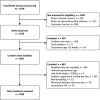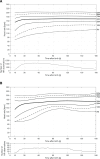Observational study comparing heart rate in crying and non-crying but breathing infants at birth
- PMID: 37028906
- PMCID: PMC10083872
- DOI: 10.1136/bmjpo-2023-001886
Observational study comparing heart rate in crying and non-crying but breathing infants at birth
Erratum in
-
Correction: 'Observational study comparing heart rate in crying and non-crying but breathing infants at birth'.BMJ Paediatr Open. 2024 Apr 16;8(1):e001886corr1. doi: 10.1136/bmjpo-2023-001886corr1. BMJ Paediatr Open. 2024. PMID: 38627061 Free PMC article. No abstract available.
Abstract
Background: Stimulating infants to elicit a cry at birth is common but could result in unnecessary handling. We evaluated heart rate in infants who were crying versus non-crying but breathing immediately after birth.
Methods: This was single-centre observational study of singleton, vaginally born infants at ≥33 weeks of gestation. Infants who were crying or non-crying but breathing within 30 s after birth were included. Background demographic data and delivery room events were recorded using tablet-based applications and synchronised with continuous heart rate data recorded by a dry-electrode electrocardiographic monitor. Heart rate centile curves for the first 3 min of life were generated with piecewise regression analysis. Odds of bradycardia and tachycardia were compared using multiple logistic regression.
Results: 1155 crying and 54 non-crying but breathing neonates were included in the final analyses. There were no significant differences in the demographic and obstetric factors between the cohorts. Non-crying but breathing infants had higher rates of early cord clamping <60 s after birth (75.9% vs 46.5%) and admission to the neonatal intensive care unit (13.0% vs 4.3%). There were no significant differences in median heart rates between the cohorts. Non-crying but breathing infants had higher odds of bradycardia (heart rate <100 beats/min, adjusted OR 2.64, 95% CI 1.34 to 5.17) and tachycardia (heart rate ≥200 beats/min, adjusted OR 2.86, 95% CI 1.50 to 5.47).
Conclusion: Infants who are quietly breathing but do not cry after birth have an increased risk of both bradycardia and tachycardia, and admission to the neonatal intensive care unit.
Trial registration number: ISRCTN18148368.
Keywords: neonatology; physiology; resuscitation.
© Author(s) (or their employer(s)) 2023. Re-use permitted under CC BY. Published by BMJ.
Conflict of interest statement
Competing interests: JE is employed at Laerdal Medical. AJK received PhD salary from Laerdal Foundation through a grant paid to Uppsala University.
Figures



Similar articles
-
Skin-to-skin care for procedural pain in neonates.Cochrane Database Syst Rev. 2017 Feb 16;2(2):CD008435. doi: 10.1002/14651858.CD008435.pub3. Cochrane Database Syst Rev. 2017. PMID: 28205208 Free PMC article.
-
Immersion in water during labour and birth.Cochrane Database Syst Rev. 2018 May 16;5(5):CD000111. doi: 10.1002/14651858.CD000111.pub4. Cochrane Database Syst Rev. 2018. PMID: 29768662 Free PMC article.
-
Assessment and support during early labour for improving birth outcomes.Cochrane Database Syst Rev. 2017 Apr 20;4(4):CD011516. doi: 10.1002/14651858.CD011516.pub2. Cochrane Database Syst Rev. 2017. PMID: 28426160 Free PMC article.
-
Planned early delivery versus expectant management of the term suspected compromised baby for improving outcomes.Cochrane Database Syst Rev. 2015 Nov 24;2015(11):CD009433. doi: 10.1002/14651858.CD009433.pub2. Cochrane Database Syst Rev. 2015. PMID: 26599471 Free PMC article.
-
Maternal and neonatal outcomes of elective induction of labor.Evid Rep Technol Assess (Full Rep). 2009 Mar;(176):1-257. Evid Rep Technol Assess (Full Rep). 2009. PMID: 19408970 Free PMC article.
Cited by
-
Significance of Neonatal Heart Rate in the Delivery Room-A Review.Children (Basel). 2023 Sep 14;10(9):1551. doi: 10.3390/children10091551. Children (Basel). 2023. PMID: 37761512 Free PMC article. Review.
-
Immediate heart rate changes in late preterm infants receiving resuscitation in the delivery room.J Perinatol. 2025 Feb 13:10.1038/s41372-025-02220-5. doi: 10.1038/s41372-025-02220-5. Online ahead of print. J Perinatol. 2025. PMID: 39948353 Free PMC article.
-
Trajectories of brain and behaviour development in the womb, at birth and through infancy.Nat Hum Behav. 2024 Jul;8(7):1251-1262. doi: 10.1038/s41562-024-01896-7. Epub 2024 Jun 17. Nat Hum Behav. 2024. PMID: 38886534 Review.
References
Publication types
MeSH terms
LinkOut - more resources
Full Text Sources
